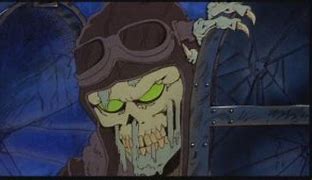My formulations on observations re: static and dynamic alignment in Part 5 only discussed villains appearing in serial features in subordinate roles. But the same distinctions apply to all Sub characters, including those that might ordinarily be described as "support-cast" members.
In ASPIRIN FOR ANTHOLOGIES PT. 3, I took pains to establish that the 1981 HEAVY METAL anthology-film was a crossover-movie, but not because some of its stories adapted icons from established features, specifically "Den," "Captain Sternn," and "So Beautiful So Dangerous." If the film had just introduced each story with some non-diegetic interlocutor figure akin to EC Comics' Crypt Keeper, then there would have been no crossover-elements. But the demonic Loc-Nar, a creation of the movie-script, both tells the stories and participates in them as an icon with agency-- though not more agency than any of the characters with which Loc-Nar interferes. It's possible that the deleted "Neverwhere Land" sequence might have shown Loc-Nar with true agency, since it involved him creating an entire civilization, only to destroy it. But in the existing sequences, Loc-Nar usually just sets events in motion. He causes comical consequences in "Dangerous" and "Sternn," heroic ones in "Harry Canyon," "Den," and "Taarna," and tragic ones in "B-17," but in each story the primary agency is not Loc-Nar but those he influences. Even "B-17," in which Loc-Nar wreaks an unalloyed evil by turning a dead airman crew into killer zombies, the primary agency rests with the animated cadavers, who attack the plane's pilots. One pilot escapes the assault and parachutes down to an island-- where, it would appear, Loc-Nar has also animated the corpses of other slain airmen. The agency here is with the living dead men, for though they have no conscious motives, they arouse revulsion in the viewer out of the conviction that if the dead could come to life, they would seek to slay those still living, for spite if nothing else.
In formal anthologies-- that is, collections of completely separate stories that may have a "guest-host" interlocutor-- the agency of the story's Prime icon or icons appear within the story proper, and if the tale-teller could be deemed any sort of status at all, he would be a Sub rather than a Prime. The only way an interlocutor could become a Prime would be to enter the story proper and assume agency through specific actions. "Horror Beneath the Streets," a 1950 tale in HAUNT OF FEAR #17, posits that the two writers of EC Comics, William Gaines and Al Feldstein, begin discussing the idea of publishing magazines devoted to horror stories. They are then duly ambushed by the Old Witch, the Crypt Keeper, and the Vault Keeper, who force the beleaguered authors to give them all contracts to host their own respective titles. Clearly the horror-hosts are the stars of this story, and one could even deem "Streets" a crossover of characters who are usually subordinate icons in other, otherwise-unrelated stories.
However, in another EC story the Old Witch enters a story but just remains another type of Sub. "A Little Stranger," in HAUNT OF FEAR #14, depicts the romance of two Prime characters, vampire Elicia and werewolf Zorgo, whose unholy unison begets the Witch herself, who's only in the story proper for one panel.
Since Part 6 ended up running extra-long with its analyses, I'll save the actual remarks on static and dynamic alignment for Part 7.





No comments:
Post a Comment